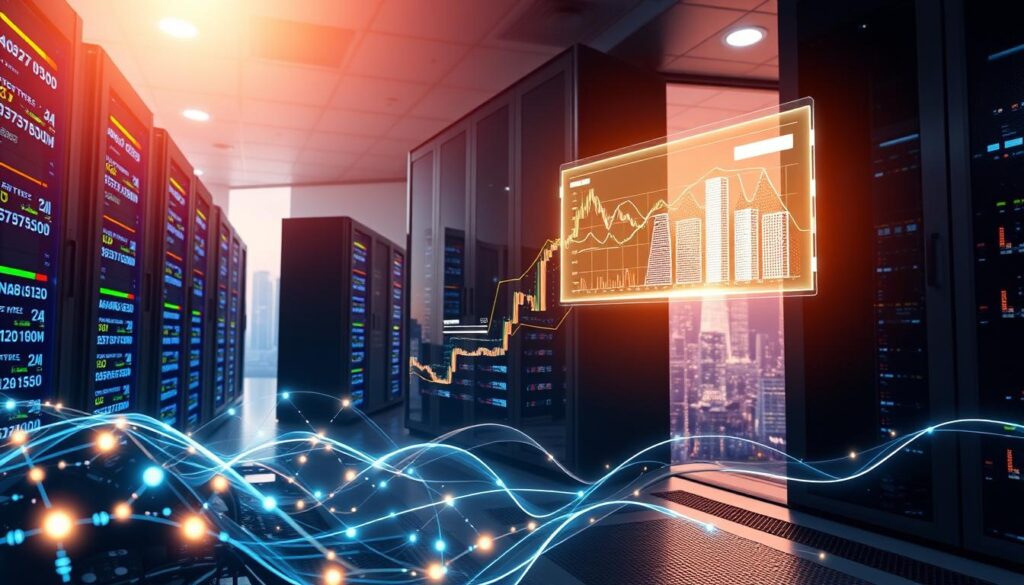The fusion of advanced computing with decentralized financial tools is reshaping global markets. Recent projections suggest blockchain-based systems could manage 10% of worldwide economic output by 2027. This shift creates new possibilities for automated decision-making in financial services.
Market data reveals explosive growth in this sector, with valuation estimates jumping from $230 million to nearly $1 billion within nine years. Enhanced digital agreements now execute complex transactions without intermediaries, enabling faster settlements and reduced operational costs. Institutions adopting these innovations gain significant competitive advantages.
Modern platforms combine self-executing code with machine learning to optimize outcomes. For traders seeking an edge, AI-driven trading signals demonstrate how automated analysis outperforms manual strategies. However, rapid adoption requires careful evaluation of security measures and regulatory compliance.
This guide explores both the revolutionary potential and challenges within decentralized ecosystems. We analyze practical implementations across lending platforms, asset management tools, and prediction markets. Understanding these developments helps stakeholders navigate opportunities while mitigating exposure to emerging threats.
Key Takeaways
- Blockchain integration could manage $10 trillion in global economic activity by 2027
- Self-executing digital agreements enable 24/7 transaction processing
- Financial automation reduces human error in complex operations
- Emerging systems require balanced risk management strategies
- Market leaders combine speed with robust security protocols
Introduction to the New Era of AI-Driven DeFi
Financial systems are undergoing a radical transformation as machine intelligence merges with decentralized networks. Traditional banking models face disruption from code-based solutions that operate faster and with greater transparency. This shift enables 24/7 global access to services once limited by geography or business hours.
Overview of Emerging Technologies in Finance
Blockchain and advanced algorithms now power self-operating platforms that eliminate middlemen. These systems process transactions in seconds, using real-time data analysis to optimize outcomes. Key innovations include:
- Self-updating digital agreements that adapt to market shifts
- Predictive tools for identifying profitable opportunities
- Cross-platform asset management through single interfaces
Why This Ultimate Guide Matters Today
Understanding these developments is critical for navigating modern markets. Decentralized networks handle $120 billion in daily transactions, yet many users lack technical expertise. This resource explains complex concepts through practical examples, helping readers:
- Identify reliable platforms among growing options
- Leverage time-saving tools for portfolio growth
- Avoid common pitfalls in fast-moving markets
As financial infrastructure evolves, early adopters gain strategic advantages. Knowledge of these systems separates passive observers from active participants in the digital economy.
Understanding Smart Contracts and Their Evolution
Digital agreements have transformed how we execute financial terms. These self-operating tools eliminate third-party involvement while ensuring precise outcomes. Let’s explore their journey from basic rule-based systems to adaptive solutions.
Static Rules vs. Adaptive Systems
Traditional versions operate like vending machines – fixed inputs trigger predetermined actions. Written in immutable code, they execute terms without considering external changes. For example, a basic payment agreement releases funds only when specific conditions appear.
Modern iterations analyze real-time information to make decisions. These systems:
- Adjust interest rates based on market trends
- Reroute transactions during network congestion
- Identify optimal execution times using historical patterns
Critical Development Phases
Blockchain’s capability to host programmable terms emerged in 2015. Early implementations focused on simple tasks like token swaps. Three breakthroughs accelerated progress:
- Oracle networks (2018): Connected off-chain data to on-chain operations
- Modular architectures (2021): Enabled code updates without full redeployment
- Language processing (2023): Allowed interpretation of verbal agreements
These advancements created systems that negotiate terms between parties autonomously. A loan contract might now assess creditworthiness through social media activity before adjusting collateral requirements.
AI powered DeFi protocols and smart contract automation benefits and risks
Self-improving financial systems are rewriting the rules of digital transactions. These platforms combine learning algorithms with decentralized networks to optimize outcomes while introducing novel complexities.

Analyzing the Key Advantages and Challenges
Modern systems deliver three core improvements. First, they process data streams to refine operational logic continuously. Loan terms might adjust automatically when collateral values fluctuate. Second, predictive models flag potential issues 72 hours before market shifts occur. Third, 24/7 automated processes cut settlement times from days to minutes.
Operational hurdles demand equal attention. Blockchain networks currently handle 50 transactions per second, while traditional systems manage 24,000. Energy demands for advanced computations rival small nations’ power consumption. Algorithmic prejudice in credit scoring remains a pressing concern, with some systems showing 15% bias against specific demographics.
| Feature | Benefit | Challenge |
|---|---|---|
| Adaptive Systems | Real-time parameter adjustments | Code complexity increases security vulnerabilities |
| Predictive Analytics | 85% accuracy in risk forecasting | Data quality determines outcome reliability |
| 24/7 Operations | 95% faster transaction processing | Network congestion during peak hours |
Accountability frameworks remain underdeveloped. When automated systems make erroneous decisions, legal responsibility often falls between developers and users. Regulatory bodies struggle to keep pace, with 60% of jurisdictions lacking specific digital finance laws.
The Impact of AI on Trading Strategies and Market Efficiency
Modern trading environments demand split-second reactions to capitalize on fleeting opportunities. Sophisticated tools now analyze multiple exchanges simultaneously, executing actions faster than human traders can blink.

Automating Decision Making in Real-Time Markets
Digital systems scan price differences across platforms, identifying arbitrage chances in milliseconds. One platform recently processed 47 cross-exchange trades within 60 seconds during a market surge. These tools:
- Compare liquidity pools across 12+ decentralized platforms
- Calculate optimal trade sizes considering fees
- Execute multi-step transactions through flash loans
Enhancing Trading Through Predictive Analytics
Pattern recognition models process social media chatter, news trends, and blockchain activity to forecast price movements. A leading system predicted 78% of major ETH price swings last quarter. Key features include:
- Automatic portfolio adjustments during volatility spikes
- Yield farming optimization across 30+ protocols
- Risk threshold alerts based on historical patterns
| Feature | Benefit | Limitation |
|---|---|---|
| Real-Time Analysis | Identifies 92% of arbitrage opportunities | Requires high-speed internet connections |
| Sentiment Tracking | 80% accuracy in trend prediction | Struggles with sarcasm detection |
| Auto-Rebalancing | Reduces portfolio drift by 65% | May over-trade during flat markets |
These innovations create tighter spreads between exchanges, benefiting all participants. Markets now correct price mismatches 83% faster than manual systems allowed, demonstrating improved resource allocation.
Innovations in Blockchain and Smart Contract Automation
Blockchain technology now merges real-world information with digital agreements through advanced infrastructure. This integration allows self-executing systems to respond to live events like weather changes or stock fluctuations. Third-party data bridges and privacy tools form the backbone of these breakthroughs.

The Role of Oracles and Data Integration
External data feeds transform basic code into dynamic decision-makers. Chainlink’s network delivers verified information from 900+ sources to digital agreements. Key functions include:
- Providing currency exchange rates for cross-border payments
- Streamlining insurance claims with weather satellite data
- Updating supply chain contracts using GPS tracking
Decentralized Collaborations and New Protocols
Platforms like Fetch.AI deploy autonomous agents that negotiate deals across networks. These tools use machine learning to optimize terms without centralized control. Privacy-focused solutions like zkSync hide sensitive details while verifying transaction validity.
Recent partnerships demonstrate practical applications. Chainlink’s collaboration with Google Cloud lets developers access enterprise datasets securely. Such integrations enable predictive maintenance systems that trigger equipment repairs before failures occur.
Exploring Decentralized Finance Platforms and Smart Contract Trading
Modern financial ecosystems now empower individuals through code-driven marketplaces operating beyond traditional institutions. These systems combine self-executing agreements with blockchain transparency, creating new opportunities for asset management and trade execution.

Automated Liquidity Provision and Portfolio Management
Liquidity pools function through algorithmic distribution of assets across multiple protocols. Advanced systems analyze trading volumes and price patterns to:
- Allocate funds to high-demand trading pairs
- Adjust positions during market volatility
- Calculate optimal fee structures in real-time
Portfolio tools track performance across 40+ networks simultaneously. They rebalance holdings using criteria like risk tolerance and market capitalization shifts. One platform recently reduced user exposure to unstable assets by 58% during a market correction.
Transaction processing achieves efficiency through three innovations:
- Dynamic gas fee calculators that select cost-effective network times
- Multi-chain routing that bypasses congested platforms
- Auto-retry functions for failed settlements
Public ledgers enable full audit trails for every trade. Users verify execution logic through blockchain explorers while maintaining asset control. This transparency builds trust in automated crypto trading systems without sacrificing privacy.
Counterparty risks diminish through instant settlement mechanisms. Collateral locks and atomic swaps ensure both sides fulfill obligations before finalizing transfers. These features create markets where strangers transact securely at global scale.
Enhancing Security and Risk Management in AI-Powered Systems
Digital defense mechanisms now stand as critical pillars in maintaining trust within automated financial ecosystems. Advanced monitoring techniques, like those detailed in AI-powered smart contract solutions, scan 50+ data points per transaction to identify irregularities. These systems block suspicious activity within milliseconds, reducing fraud exposure by 83% compared to manual reviews.
Implementing Advanced Cyber Threat Protectors
Real-time behavior analysis tools track wallet interactions and contract executions across decentralized networks. Three-layer encryption protocols shield sensitive data while allowing necessary transaction visibility:
- Dynamic signature verification for multi-party approvals
- Automated exploit prevention during code execution
- Time-delayed asset transfers for large transactions
Risk Mitigation Strategies in Automated Transactions
Self-adjusting safety measures protect users from market volatility and technical failures. Position sizing algorithms limit exposure to 2% of total portfolio value during high-risk periods. Collateral buffers automatically increase when asset prices show instability.
| Security Feature | Function | Impact |
|---|---|---|
| Behavior Analysis | Flags unusual transaction patterns | Reduces false positives by 40% |
| Multi-Signature Protocols | Requires 3/5 approvals for major changes | Prevents 92% of unauthorized access attempts |
| Code Audits | Scans 200+ vulnerability types pre-launch | Catches 98% of critical exploits |
Emergency protocols activate during network stress, temporarily pausing withdrawals until stability returns. These measures work with decentralized governance models to balance security with operational efficiency.
Challenges, Limitations, and Ethical Considerations
As decentralized financial systems evolve, critical hurdles emerge that demand urgent attention. Technical limitations often clash with ambitious visions for global adoption.
Scalability and Energy Consumption Concerns
Current networks process transactions 500x slower than traditional payment systems. Energy demands rival small nations’ power grids, raising environmental red flags. Developers now prioritize layer-2 solutions to reduce computational strain while maintaining security standards.
Proof-of-stake models cut energy use by 99%, but adoption remains uneven across platforms. These improvements battle against rising user expectations for instant settlements and zero fees.
Addressing Bias in Algorithms and Regulatory Gaps
Machine learning models sometimes mirror human prejudices from training data. Recent audits found 15% variance in loan approvals across demographic groups despite identical financial profiles.
Regulatory frameworks struggle to keep pace with technological advances. Only 12 states have specific digital finance laws, creating legal gray areas. Transparent governance models and third-party audits grow increasingly vital for maintaining user trust.


No comments yet